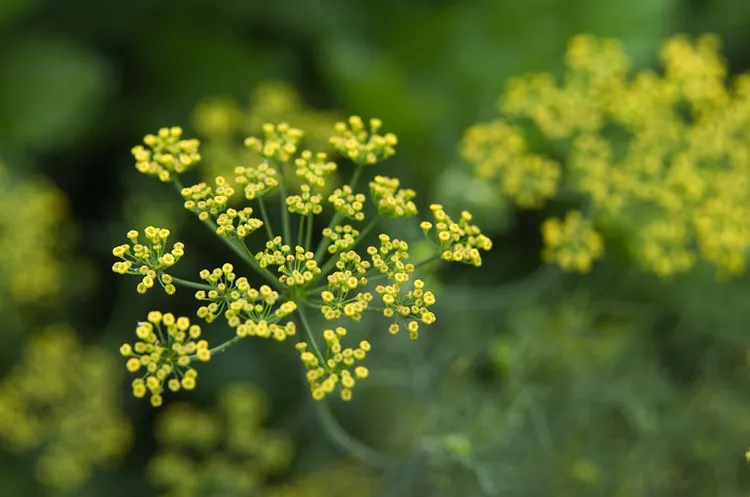Dill (Anethum graveolens) is a fantastic companion plant in the garden. This richly fragrant and fast-growing herb doesn’t take up a lot of space, fitting right into container gardens, herb beds, and vegetable patches. Wherever you plant it, here are the best companion plants for dill that need the same growing conditions. Many even contribute natural garden pest control to dill or enjoy protection from the beneficial insects dill attracts.
Asparagus
It can be challenging to find plants to grow in asparagus beds since asparagus takes up a lot of space and is a slow grower. However, compact dill plants slip in easily between asparagus crowns, filling empty soil space and keeping garden beds as productive as possible. Flowering dill can also keep common asparagus pests at bay by attracting beneficial insects.
Basil
Basil is a tender-stemmed herb that loves moist soil and regular watering, much like dill. Aside from their similar care requirements, these plants both tolerate indoor growing and don’t take up much space. Even if you have only a sunny windowsill to grow on, you can count on basil and dill to keep your kitchen flush with fresh herbs.
Brassicas
Dill is an easygoing herb that grows well with most vegetables. However, it’s particularly well-suited for growing near brassicas. Brassica vegetables, including cabbage, broccoli, and Brussels sprouts, are prone to cabbage looper caterpillars, which can riddle plant leaves with holes. Dill flowers attract hoverflies and parasitic wasps that feed on brassica pests and help keep your veggies pest-free.
Chervil
Dill is relatively resistant to many insects, but two garden pests that love gobbling up dill plants are slugs and snails. These voracious critters can devour a tender crop of dill in an evening and leave you with nothing but bare stems by morning. However, slugs and snails prefer chervil plants to dill, so planting chervil in your garden can lure these pests away from dill and other vulnerable crops.
Cilantro
Cilantro and dill have similar growing needs and get along nicely in the garden. These herbs tolerate cool weather and some light shade, and their compact size makes them suitable for growing in gardens or containers. On top of that, cilantro flowers are also highly attractive to beneficial insects. You can make your garden less hospitable to pests by growing these two flowering herbs together.
Corn
Dill’s short stature makes it a less obvious plant companion for corn, but these two edible crops complement each other’s growth in the garden. Corn plants are prone to an assortment of insect pests, such as corn earworms and armyworms. However, if you let dill plants flower near your corn crop, the dill flowers lure in hoverflies and other beneficial insects that keep corn pests in check.
Cucumbers
If you like making homemade pickles, growing dill plants around your cucumbers makes sense. Not only does this plant partnership provide all the fresh dill and cucumbers you need for homemade pickles, but dill also attracts beneficial insects and shields cucumber vines from pest activity. Dill flowers appeal to “good guy” insects, so if you want to get the most out of dill, allow your plants to bloom.
Lettuce
In the garden, lettuce and dill are a match made in heaven. These two plants both favor cool temperatures and moist soil. Beyond their similar care requirements, dill also may deter some insects from nibbling on lettuce leaves.
Onions
Onions are among the most versatile companion plants because their strong scent deters many insect and animal pests. When paired with dill, onions can repel carrot flies, which often feed on dill roots, impairing the growth of the plants. Onions and dill also have different root systems, so they don’t compete for soil space—and they make delicious additions to pickle recipes.
Tomatoes
Tomatoes and dill have a complex relationship, but they can be used as companion plants as long as you follow a few simple guidelines. Young dill plants are known to boost the growth of tomatoes, and their ability to attract beneficial insects can control tomato hornworms. However, mature dill plants can interfere with tomato growth, so it’s best to pull up dill plants when they start to flower if you want to grow these plants together.




















